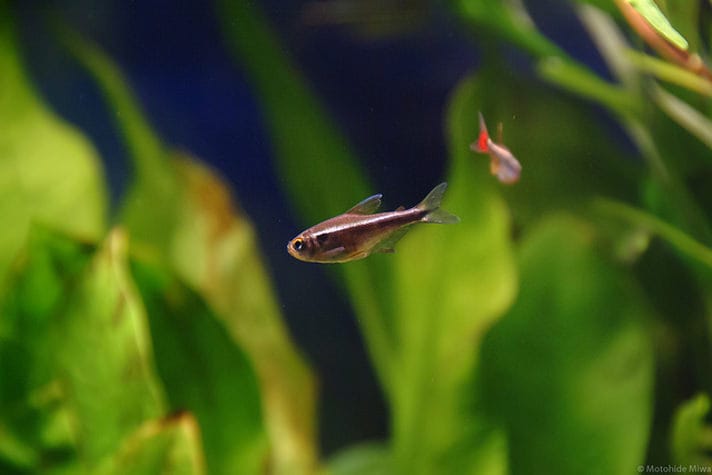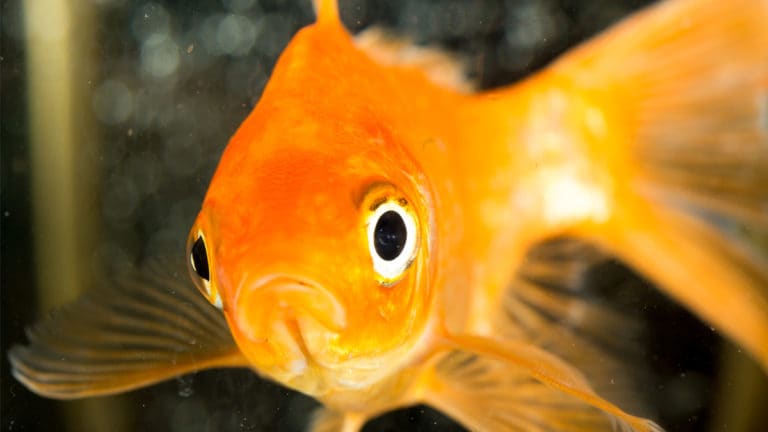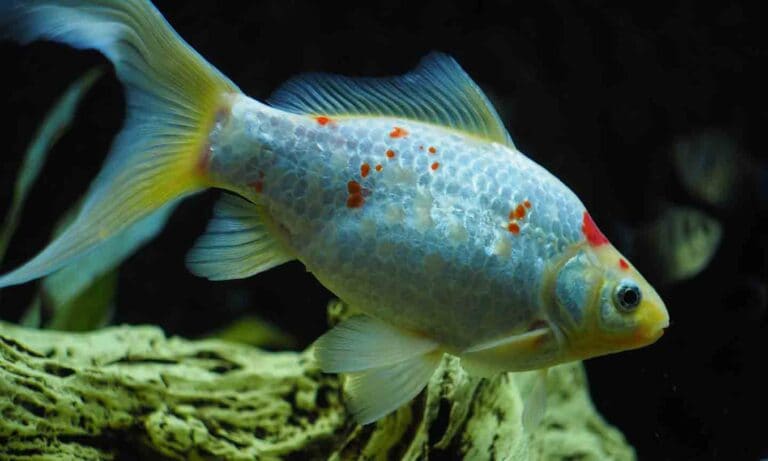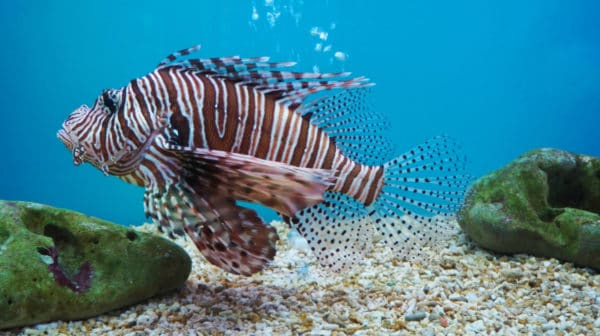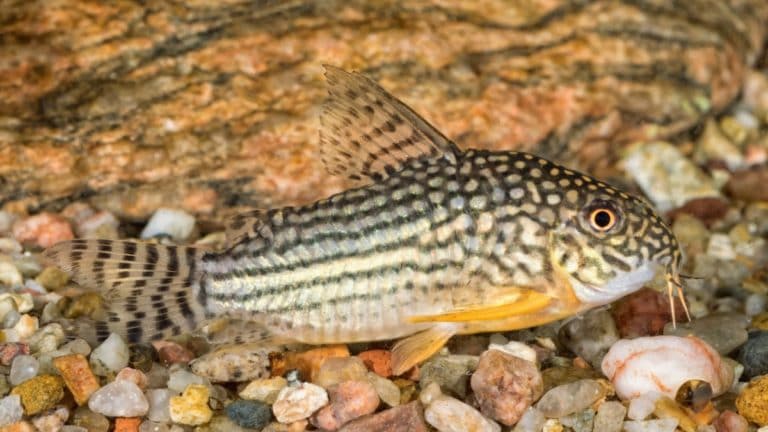It was brought to my attention some time ago that one of the easiest to cultivate live foods, Daphnia, is rarely offered in tropical fish shops. This seems odd, because I’ve had a surplus of this invaluable fish food for many years, which I have sold to customers in my aquarium store. In fact, hundreds of customers have confirmed what I have found myself: feeding live Daphnia results in a remarkable improvement in the appearance, health and longevity of fish. These irresistible, tasty little morsels don’t cause indigestion or constipation and are non-fattening. I’d like to share with you how easy it is to create a perpetual live food reservoir that requires little effort, knowledge or cost.
What Are Daphnia?
Technically speaking, Daphnia (pronounced daff-knee-uh) is a tiny crustacean (aquatic anthropod) that resembles a flea. Normally, they range in size from 1/50th to about ¼ of an inch in size, and are usually off-white to semi-transparent in color. They have gills for breathing underwater.
A keen observer can actually see the eggs a female is carrying. Daphnia possess two branch-like arms that they use for locomotion — similar to dog paddling, but much more erratic. They race around gobbling up anything in sight that is edible. These hungry characters devour numerous kinds of micro-organisms and organic matter. One of their favorite meals is Euglena, the green-colored organism that shows up in ponds and aquariums as “pea soup” green water. Daphnia also like to gorge themselves on unicellular algaes, vegetable matter, yeast, dried milk, egg yolk and even manure.
These little water fleas, as they are sometimes called, love to propagate, and are most enticed to do so in alkaline water (above pH 7.0) that is between 65 and 75 degrees Fahrenheit, with medium light intensity. Incredibly, they are quite content in a relatively small volume of water as long as there is enough food and oxygen to support them. I have successfully kept more than a thousand of them in a gallon of water for several weeks before it was necessary to reduce their population.
One of the reasons Daphnia are able to multiply quickly — from conception to adulthood takes approximately one week — and in such vast numbers is because the females can reproduce with or without the aid of males. During times of plenty, the females cleverly produce more females to take advantage of the excess food supply. Males are able to manufacture “special” eggs that are designed to continue the survival of the species in the event of a major environmental change, such as a drought. These eggs can lie dormant for extended periods of time. In an artificially created environment in which the best conditions are continuously maintained, however, the maximum reproductive potential of a culture can be realized. For Daphnia this means producing the greatest number of females, which results in even more births, and so on.
Daphnia are a form of plankton. They fair best in calm or still water, such as that found in small ponds. Just about any place that combines fresh water and the right conditions can be a sanctuary for Daphnia. In nature’s grand design, however, Daphnia are imprisoned in the lower end of the food chain, where they serve as food for larger aquatic creatures, such as small or young fish.
Basically, Daphnia provide two primary vitamins that are of vital importance to fish — vitamins A and D. Vitamin A is essential for the growth and development of fish, and it also serves as an excellent anti-infective agent. Vitamin D is primarily responsible for the production of bone, and all vertebrates are therefore dependent on it. Daphnia also offer small amounts of vitamins B and C, which vary in quantity depending on what foods the Daphnia have consumed. Vitamin B supports tissue growth and stimulates appetite. Vitamin C aids in skin formation and coloration. Finally, Daphnia provide protein, carbohydrates (sugars and starches) and fats.
There are numerous advantages to offering Daphnia in comparison to a diet consisting exclusively of dried foods. Dried foods typically lack essential vitamins. Daphnia provide the necessary vitamins in proportionally balanced quantities. Because they are a live food, Daphnia activate a fish’s instinct to hunt. Overfeeding Daphnia to aquarium fish will not pollute aquarium water because they will live until eaten later on. It costs much less to provide Daphnia to your fish. Unlike with brine shrimp, there are no difficult or costly requirements needed to cultivate Daphnia to adulthood.
How to Successfully Establish a Thriving Culture
To begin with, it is essential to have a food supply for feeding the Daphnia well in advance. What is needed is a container to hold four times the volume of water of the container that will house the Daphnia. Ideally, a 10-gallon aquarium can be used for this purpose.
The aquarium must be located in a spot where the maximum constant quantity of sunlight will come in contact with it. A south-facing windowsill is an excellent location. Otherwise, a fluorescent light must be placed directly on the top of the aquarium and remain lit for 18 to 20 hours per day (with a four-hour period of darkness between light cycles). Because the winter season drastically reduces the intensity and duration of sunlight, it may be necessary to supplement natural light with artificial light. To determine this, you must discover how long it takes to turn clear water to green. For instance, it would be self-defeating if the food reservoir took months to develop only to be consumed by the greedy Daphnia in a few days. There must be enough light to provide a constant source of green water. The key to successfully raising Daphnia is to maintain an abundant supply of micro-organisms.
The aquarium should be filled with hard (above 100 parts per million total dissolved solids), alkaline (preferably above pH 8.0) water. You do not need to add a filter, airstone, gravel or anything else to the aquarium. With a little time (less than two weeks) and a lot of light, the water should turn green and darken with age. To speed this process up a bit, add two or three good-sized feeder goldfish (about 2 inches in length). Using this method, it is possible to develop thick green water in less than a week. Once visibility has been reduced to the point where an object 2 inches from the aquarium glass is difficult to distinguish, you are ready to begin your Daphnia cultures.
The next step is to select suitable containers to take with you when you go out to find and collect Daphnia. Although some collectors choose canning jars for this purpose, I have found that 1-gallon wide-mouthed glass jars work the best. You will need only two to get started. Frequently, local supermarkets or restaurants use this size jar — often throwing them away. If all else fails, you can always purchase a gallon of something (such as fruit or mayonnaise) with the intention of salvaging the jar after the contents have been consumed. You won’t need the lids.
Daphnia can be collected virtually any time of the year from any natural body of shallow fresh water (without strong currents) by using a brine shrimp net and a jar. By stirring the bottom slightly — even through a hole in the ice — with a few figure-eight sweeps with a net, you should have good results. For those who are unwilling to venture outdoors during the winter, have no fear. The peak season for Daphnia runs from May to July, making weather no obstacle. During these peak periods, it’s possible to capture a multitude of Daphnia just by dipping the jar in the water. If you find a body of water that is populated by tadpoles, you will most assuredly reap an astonishing number of creatures in just a few seconds.
When you return home with your prize, scrutinize it thoroughly for any aliens that may be accompanying the Daphnia. Some innocent-looking creatures are often predaceous monsters that are detrimental and even lethal to fish. They must be identified and removed! A short list of unwanted characters that might have come along for the ride include Notonecta (a water bug), dragonfly nymphs and hydra, all of which are notorious for attacking small fish. If you have any doubt at all when it comes to some strange-looking thing, discard it. It’s not worth the risk.
If, for one reason or another, you are unable to collect your own Daphnia, try purchasing them from someone. Many wise fish farmers are already using them and probably have plenty to spare. One-half pint of live Daphnia sells for about a dollar.
Fill two jars with green water from the 10-gallon aquarium and place them in a location with medium light intensity that is about room temperature (72 degrees Fahrenheit). Pour the Daphnia into a small plastic bag and allow it to float in the 10-gallon aquarium for 10 minutes. This will help equalize the water temperature in the bag with that in the jars. Using a cup, double the volume of water in the bag of Daphnia with water from the aquarium. Let the bag sit another 10 minutes. This will allow the Daphnia to gradually adjust to a different water chemistry.
Carefully pour the bag of Daphnia through a brine shrimp net and discard the water in the bag. Place the Daphnia in one of the gallon jars. That’s it! Your culture has been activated. Those tiny crustaceans will be thrilled with all the food that is available. Depending on the quantity of Daphnia that has been added to the first jar (at least 100 or so), it will likely be several days before a noticeable difference takes place.
As the Daphnia gorge themselves and increase in number, the green water will begin to clear, eventually clearing completely. At this point, you can remove some of the Daphnia with either the brine shrimp net or a kitchen baster. These Daphnia can be fed to your fish. However, a substantial portion must always be left in the jar to keep the species multiplying. If you become too greedy at this stage of the game, you may end up with nothing.
The decision to regulate the population of your food source should be made cautiously — it’s a totally subjective judgment call. If, on the other hand, you postpone the partial removal of some of the Daphnia, excessive numbers will cause them to eat themselves out of existence. Learn to watch for signs of distress.
Being certain that the green water has become clear in the first jar, pour the entire contents through the brine shrimp net. Throw away the exhausted water and place the remaining hungry Daphnia into the second jar of fresh green water. After thoroughly rinsing the first jar with plain water (no soap), refill it with green water from the holding aquarium.
At this point it should be obvious that the 10-gallon aquarium has much less water in it. Therefore, it must be filled with fresh, dechlorinated water that is hard and alkaline. Water from an established aquarium housing fish that would normally be discarded after a partial water change could be used, provided it isn’t acidic and soft. A simple formula for raising the pH and alkalinity of water is to add 1 level teaspoon of sodium bicarbonate (baking soda) to 20 gallons of water in order to raise it 0.1 on the pH scale.
During these periodic transfers of either Daphnia to water or water to water, never allow any crustaceans to enter your green water reservoir or it will be destroyed. After a few weeks of moving Daphnia back and forth between jars, the colony should be large enough in numbers that a significant amount of Daphnia can be consistently taken without weakening or threatening the ability of the cultures to regenerate.
You will observe that Daphnia are eagerly accepted by most (if not all) species of fish, and that noticeable improvements in their condition soon follow. If you would like to increase the volume of live food, the green water reservoir should be increased in size. A gallon of Daphnia can provide a substantial amount of nutrition for several dozen small fish.
Some additional foods that are readily taken by Daphnia include tiny pieces of the outer green leaves of lettuce, a tweezer-size pinch of baker’s yeast or dried milk added once a week, and even one or two drops of fry food per week. The advantage of green water is that it is essentially free to produce and is very nutritious for the Daphnia.
As a final note, there are about 20 types of Daphnia found in the United States. There are also other types of micro-organisms, such as cyclops (commonly called water mites — excellent for feeding newborn fry) and cypris (sometimes known as seed shrimp), that are raised in the same manner as Daphnia with equal ease.
Posted by: Chewy Editorial
Featured Image: Via Moto “Club4AG” Miwa/Flickr
Share:
